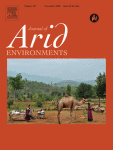Ver ítem
- xmlui.general.dspace_homeCentros Regionales y EEAsCentro Regional Buenos Aires SurEEA Hilario AscasubiArtículos científicosxmlui.ArtifactBrowser.ItemViewer.trail
- Inicio
- Centros Regionales y EEAs
- Centro Regional Buenos Aires Sur
- EEA Hilario Ascasubi
- Artículos científicos
- Ver ítem
Natural distribution and phenotypic traits of Neltuma flexuosa var. depressa, a candidate taxon for the rehabilitation in the central arid region of Argentina
Resumen
Dryland rehabilitation in the central arid region of Argentina is urgently needed to reverse the current high levels of degradation. Neltuma flexuosa var. depressa, adapted to arid environments, gives it the potential to be used in rehabilitation, for extensive livestock grazing and apiculture. When the soil seed bank is exhausted and natural regeneration is impossible, seed-based rehabilitation programmes constitute one of the more promising options.
[ver mas...]
Dryland rehabilitation in the central arid region of Argentina is urgently needed to reverse the current high levels of degradation. Neltuma flexuosa var. depressa, adapted to arid environments, gives it the potential to be used in rehabilitation, for extensive livestock grazing and apiculture. When the soil seed bank is exhausted and natural regeneration is impossible, seed-based rehabilitation programmes constitute one of the more promising options. Thornless ecotype selection could improve pods utilization, so studies of the population distribution can be useful as a genetic resource for pre-breeding. Niche occupancy exhibits a large latitudinal extension (32–43°S), mainly in areas of salinity. All populations would have a transient soil seed bank, but seed dormancy release was lower in populations originating in more unpredictable environments, which distributes germination across years and acts as a bet-hedging strategy between seasons. We observed differences between the populations, with greater spinescence being associated with higher isothermality and lower annual precipitation (r > 80***) at the population's place of origin, showing local adaptation. We also found some thornless seedlings (1.67%) in a population with lower spinescence. However, the plastic response of thorns in seedlings, as well as later stages, should be evaluated in stressful environments.
[Cerrar]

Fuente
Journal of Arid Environments 209 : 104889 (February 2023)
Fecha
2023-02
Editorial
Elsevier
ISSN
0140-1963
Documentos Relacionados
Formato
pdf
Tipo de documento
artículo
Proyectos
(ver más)
INTA/2019-PE-E6-I142-001/2019-PE-E6-I142-001/AR./Mejoramiento genético de leguminosas y gramíneas forrajeras para incrementar la productividad y la sustentabilidad de los sistemas agropecuarios de la Argentina
Palabras Claves
Derechos de acceso
Restringido
 Excepto donde se diga explicitamente, este item se publica bajo la siguiente descripción: Creative Commons Attribution-NonCommercial-ShareAlike 2.5 Unported (CC BY-NC-SA 2.5)
Excepto donde se diga explicitamente, este item se publica bajo la siguiente descripción: Creative Commons Attribution-NonCommercial-ShareAlike 2.5 Unported (CC BY-NC-SA 2.5)

